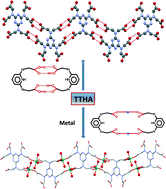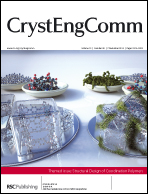Extending the supramolecular synthon concept in flexible polyaminocarboxylate based coordination polymers†
Abstract
Six coordination polymers (CPs) of 1,3,5-triazine-2,4,6-triamine hexaacetic acid (TTHA) with various metals (M = Na, solid 1; M = Mg, solid 2; M = Cu, solids 3a and 3b; and M = Zn, solids 4a and 4b) are reported and analyzed in terms of supramolecular synthons. [Na4(H3TTHA)Cl(H2O)], 1 and [Mg2(H2TTHA)(H2O)], 2 are 3D CPs involving trinuclear Na(I) clusters and two distinct (24- and 16-membered) acid–Mg(II) dimer synthons, respectively. With Cu, TTHA forms 1D and 2D CPs, [Cu2(H2TTHA)(H2O)6], 3a and [Cu2(H2TTHA)(H2O)4]·4H2O, 3b, respectively with distinct compositions. The 24-membered acid–Cu(II) dimer synthon is responsible for 1D aggregation in 3a, while alternating 24- and 4-membered acid–Cu(II) dimer synthons lead to the formation of a 2D metal–organic network in 3b. Two compositional variants are also observed with Zn: an acid–Zn(II) dimer synthon leads to the formation of a 3D CP in [Zn5Na2(TTHA)2(H2O)8], 4a and a 1D CP in [Zn2(H2TTHA)(H2O)7]·2H2O, 4b. In Cu and Zn based CPs, the crystal form is determined by the protonation states of TTHA and the method of preparation. The application of the synthon concept made structural analyses of CPs simple, which revealed structural relationships not only among them, but with the reported TTHA polymorphs.

- This article is part of the themed collection: Structural Design of Coordination Polymers

 Please wait while we load your content...
Please wait while we load your content...